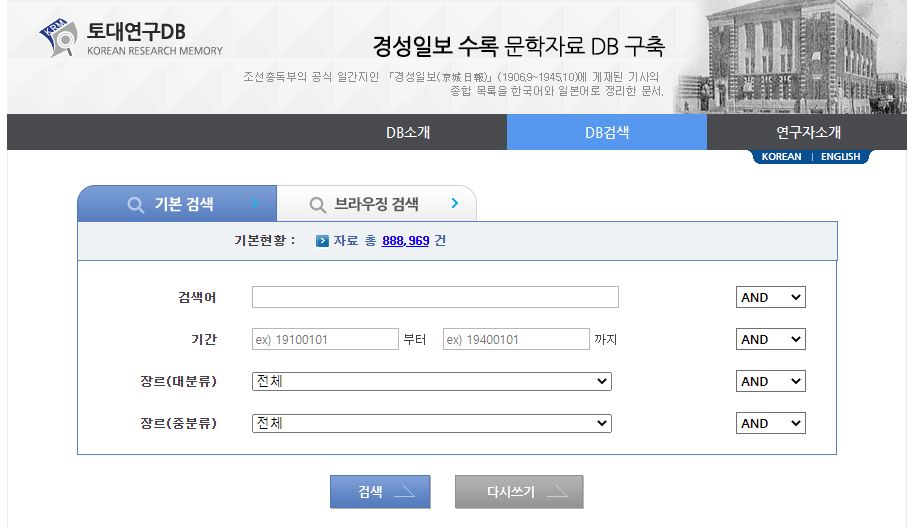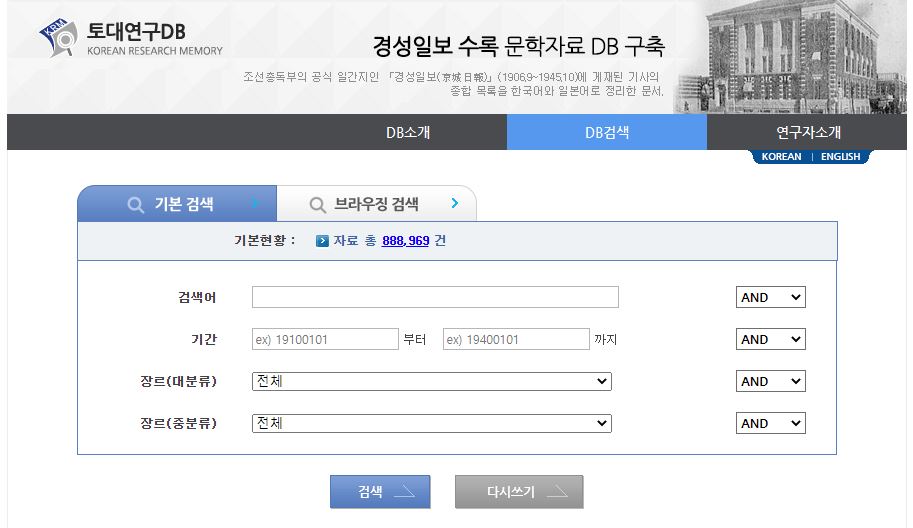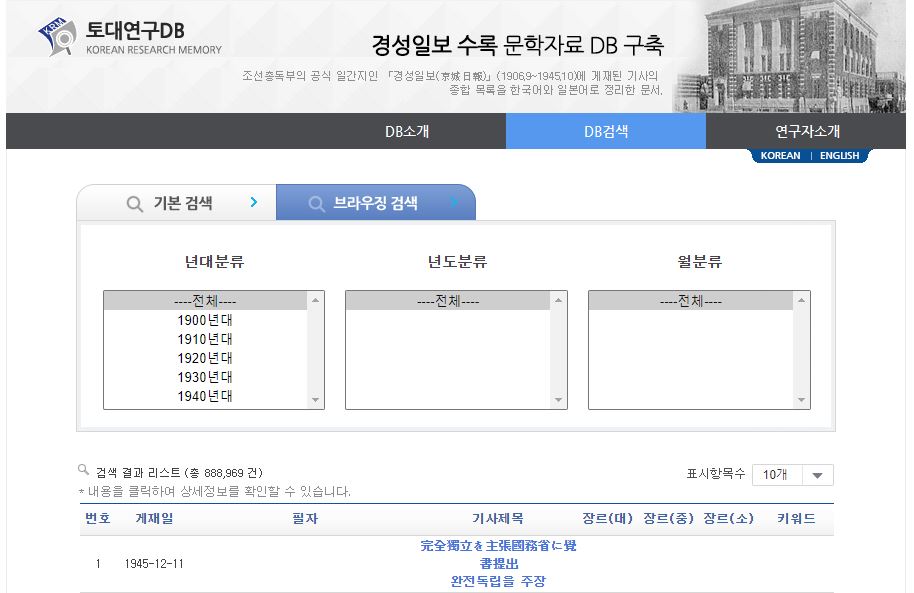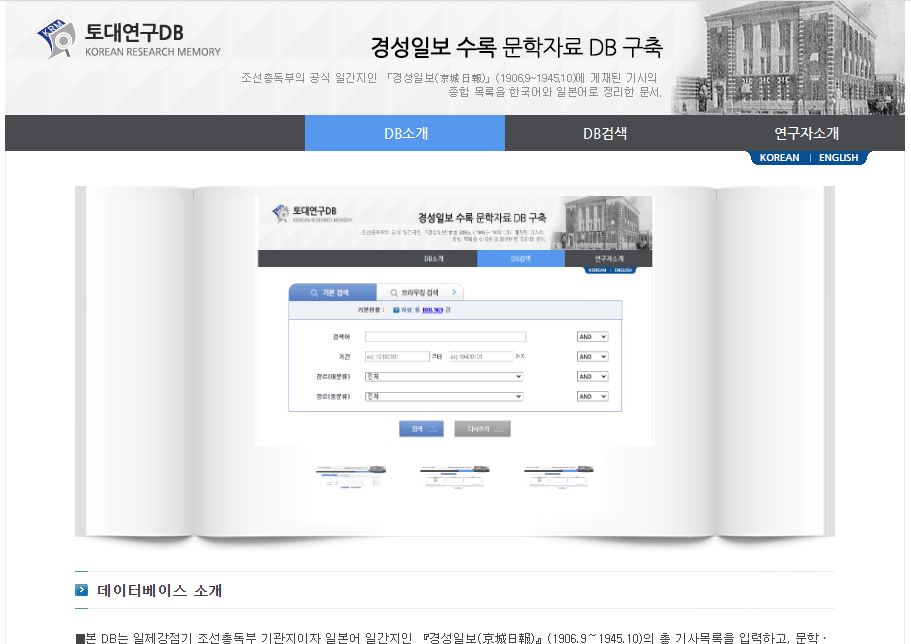 데이터베이스 소개
데이터베이스 소개
■본 DB는 일제강점기 조선총독부 기관지이자 일본어 일간지인 『경성일보(京城日報)』(1906.9~1945.10)의 총 기사목록을 입력하고, 문학・문학 문화 자료의 경우 본문 내용을 확인하여 대・중・소로 상세 장르를 분류하여 한일 양국어로 본문을 검색할 수 있는 형태로 가공한 것이다. ■총기사 목록은 기사의 원제목과 필자뿐만 아니라 그것의 한국어 번역 입력이 병행되었다. 이를 통해 『경성일보』의 총 기사목록을 한일양국어로 검색할 수 있다. ■인명을 비롯한 고유명사의 경우, 일본어로는 한자와 히라가나, 한국어로는 한자의 일본어 발음과 한국어 발음의 4가지 방법으로 표기하여 검색의 편의성을 높였다. 예를 들어 일본의 작가 ‘다니자키 준이치로(谷崎潤一郎)’를 검색하고자 할 경우, 검색자는 ‘谷崎潤一郎(한자)’ ‘たにざき じゅんいちろう(히라가나)’ ‘다니자키 준이치로(한자의 일본어 발음)’ ‘곡기윤일랑(한자의 한국어 발음)’의 네 가지 키워드로 모두 검색이 가능하다. ■ 문학・문화 관련 기사의 경우 검색의 편의성을 위해, 기사 내용을 분석하여 장르를 대・중・소로 구분하여 입력하였고, 주요 기사의 경우 본문의 한국어 번역문을 입력하였다. 이로써 문학・문화 관련 기사의 경우 장르별로 기사를 검색할 수 있고, 본문의 상세 내용도 검색할 수 있게 하였다. ■이상과 같이 본 DB는 일제강점기 최대 미디어 자료임에도 불구하고 지금까지 학문적·자료적 접근이 용이하지 않았던 『경성일보』를 다양한 방법으로 검색할 수 있게 함으로써 인문·사회과학 제 학문분야에서 활용할 수 있는 토대를 마련하였다고 할 수 있다. ■특히 기사를 한일 양국어로 입력하고, 문학・문화 기사 중 주요 기사를 선별하여 본문의 한국어 번역을 입력함으로써 일본학 연구자들만이 아니라 한국학 연구자들, 일반인 등 누구나 손쉽게 『경성일보』 자료에 접근할 수 있도록 하였다. ※ 본 DB의 기사목록을 통해 검색한『경성일보』 원문은 고려대학교 중앙도서관 웹사이트(https://library.korea.ac.kr)에서 열람할 수 있도록 각 기사별 URL을 입력해 두었다.
 기대효과/활용방안
기대효과/활용방안
■ 본 DB는 최초로 『경성일보』의 총 기사목록을 입력하여 한일 양국어로 검색이 가능하게 함으로써, 일제 강점기 한국 사회의 정치, 경제, 역사, 과학, 예술 등 인문사회과학 제 분야 연구의 활성화를 가져올 것이다. ■ 본 DB는 『경성일보』의 문학・문화 관련기사의 제목은 물론, 기사 내용을 분석하여 대・중・소 장르별로 상세 분류하여 검색의 편의성을 높였으며, 주요 기사의 경우 본문의 한국어 번역을 입력함으로써, 일제 강점기 문학・문화 연구의 활성화를 가져올 것이다. ■ 본 DB는 『경성일보』 의 총기사의 제목과 문학・문화 관련기사를 한일양국어로 검색할 수 있게 설계했기 때문에, 일본 관련 연구자뿐만 아니라 한국의 관련 분야 연구자도 쉽게 접근할 수 있다. 이로써 일제강점기를 연구하는 한국학 분야의 활성화를 가져올 것이다. 또한 일반인들도 자료에 쉽게 접근함으로써 일제강점기 한국 사회의 실상에 대한 이해와 관심이 증대될 것이다. ■ 본 DB는 『경성일보』의 총기사의 제목과 문학・문화 관련기사를 한자와 일본어로 검색할 수 있게 설계했기 때문에, 한국 내 연구자들뿐만 아니라 일본, 중국, 대만 등 동아시아의 식민지 시기 연구자들도 활용할 수 있을 것이다. 이로 인해 일제 강점기 식민지 조선을 중심으로 한 동아시아 식민지 학지(学知) 연구의 활성화를 불러올 것이다. ■ 이상과 같이 일제강점기 최대 규모의 일본어 매체인『경성일보』의 총 기사목록과 문학・문화기사의 내용을 검색할 수 있는 본 DB는, 국내외 일제강점기 연구자는 물론 일반인들도 쉽게 접근하여 활용할 수 있게 함으로써, 일제강점기를 대상으로 하는 인문사회과학 제 분야의 활성화를 도모하고 일반인들의 일제의 식민지 지배의 실상과 한일 관계에 대한 이해를 심화시킬 것이라 기대한다.
 사업명 : 인문사회연구분야 토대기초연구지원
사업명 : 인문사회연구분야 토대기초연구지원
연구책임자 : 김효순
연구수행기관 : 고려대학교
연구기간 : 5 년 (2015년 09월 01일 - 2020년 08월 31일)









